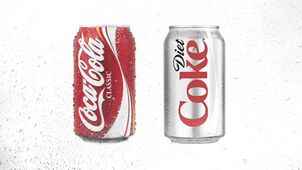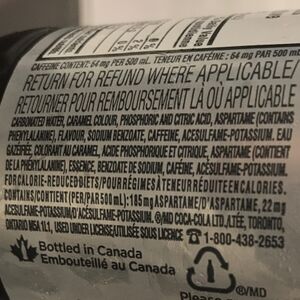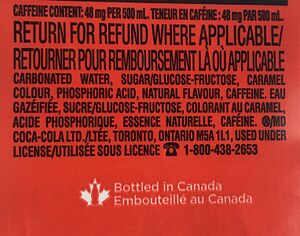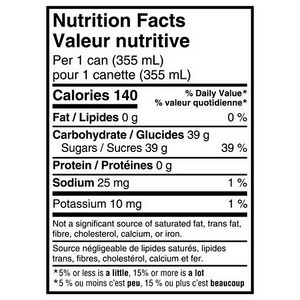Course:FNH200/Assignments/2022/Coke DietCoke
Introduction

Coca-Cola which is also known as "coke" is one of the most widely known and consumed carbonated soft drinks. However, since the introduction of Diet Coke in 1982, the popularity of the alternative drink that is targeted for those who are more health conscious has been growing steadily.[1] This webpage explores the differences of regular Coke and Diet Coke in terms of displayed ingredients, chemical compounds, and furthermore the roles of these that make Diet Coke different from regular Coke and other popular carbonated soft drinks.
Ingredient Lists




| Regular Coke | Diet Coke |
|---|---|
| Carbonated water | Carbonated water |
| Sucrose | Caramel colour |
| Caramel colour | Phosphoric acid |
| Phosphoric acid | Citric acid |
| Natural flavour | Aspartame (contains phenylalanine) |
| Caffeine | Natural flavour |
| Sodium benzoate | |
| Caffeine | |
| Acesulfame-potassium |
| Regular Coke | Diet Coke | |
|---|---|---|
| Fat Substitutes | None | None |
| Sugar Substitutes | None | Aspartame
Acesulfame-potassium |
| Additives | Caramel colour
Phosphoric acid |
Caramel colour
Citric acid Phosphoric acid Sodium benzoate |
| Substitutes/Additives | Role |
|---|---|
| Aspartame |
|
| Acesulfame-potassium |
|
| Caramel colour |
|
| Citric acid |
|
| Phosphoric acid |
|
| Sodium benzoate |
|
| In Both | Only Regular Coke | Only Diet Coke |
|---|---|---|
| Carbonated water | Sucrose | Citric acid |
| Caramel colour | Aspartame | |
| Phosphoric acid | Sodium benzoate | |
| Natural flavour | Acesulfame-potassium | |
| Caffeine |
Common Ingredients
The common ingredients between regular Coke and Diet Coke are carbonated water, caramel colour, phosphoric acid, natural flavour, and caffeine. Carbonated water, caramel colour, natural flavour, and caffeine are the essential ingredients that form the consistency and taste of Coke. Caramel colour and phosphoric acid are additives that are discussed in the previous table. The ingredients that differentiate between the two versions of Coke are discussed below.
Only Regular Coke
Regular Coke uses sucrose as its primary source of sweet flavouring.
Only Diet Coke
Diet Coke uses citric acid, which as earlier mentioned gives Coke a sour taste and helps made the beverage more fizzy.[4] As sugar substitutes, Diet Coke uses Aspartame and acesulfame-potassium. Aspartame is a low calorie sweetener, while acesulfame-potassisum is a non-caloric sweetener.[2] These are used in Diet Coke, rather than the sucrose in regular Coke, because they are healthier. They are especially better for people with diabetes or those concerned with caloric intake or cavities.[2] Lastly, Diet Coke has sodium benzoate. Sodium benzoate is added to increase the acidic flavour of Diet Coke and to prolong the shelf life.[6]
Labels
The following table shows the detailed information on the labels:
| Requirements | Regular Coke | Diet Coke |
| Name of product | Coca Cola | Diet Coke |
| Bilingual labelling | English and French | English and French |
| Nutrition facts tables | Calories -150
Fat- 0g Sodium - 30mg sugars-41g Potassium - 10mg Carbohydrate - 41g Proteins - 0g |
Calories - 0
Fats - 0 Sodium - 40mg Carbohydrate - 0g Sugars - 0g Protein - 0.1g |
| Country of origin | Canada | Canada |
| Quantity of coke | 375ml/bottle | 355mL/can |
| Date making and storage instruction | Best before date | Not shown |
| Principal place of business | Toronto, Ontario | Bottled in Toronto, Ontario |
| List of ingredients | Carbonated water, caramel colour, phosphoric acid, caffeine and natural flavour | Carbonated water, caramel colour, aspartame, natural flavours, phosphoric and citric acid, sodium benzoate (to protect taste), caffeine, acesulfame-potassium |
| Legibility and location | All of the information is easy to read and legible | All of the information is easy to read and legible |
| Sweeteners | Sucrose | Aspartame, acesulfame-potassium |
| Irradiated Foods | Not an irradiated food | Not an irradiated food |
| Nutrient content claims | Not a significant source of saturated fat, trans fat, fiber, calcium or iron | Phenylketonurics: contains phenylalanine
Caffeine content: 46mg/12fl oz Low sodium, 140mg or less per 355mL Not a significant source of saturated fat, trans fat, cholesterol, fibre, vitamin A, vitamin C, calcium or iron |
Regular Coke and Diet Coke: According to the Canadian Food Inspection Agency of Canada[7], the labels of regular coke and diet coke comply with the Consumer Packaging and Labelling Act and Regulations of Canada as they include the common name of the product, bilingual labelling (French and English), the name and principal place of business, nutrition facts tables, country of origin (Canada), net quantity of coke, date markings and storage instructions, list of ingredients, proper legibility and location of information pertaining to the product, sweeteners, and nutrient content claims.
Aspartame, the low calorie sugar substitute used for Diet Coke, has been approved by Health Canada since 1981[8]. It should be noted that the exact amount of aspartame is found on the ingredients list quantified in milligrams and that the ingredients list states "contains phenylalanine" which is in line with the Consumer Packaging and Labelling Act and Regulations of Canada[9].
References
- ↑ "Diet Coke". National Museum of American History. Retrieved July 17, 2022.
- ↑ 2.0 2.1 2.2 2.3 "Types of Sugar Substitutes - Sweeteners". UBC Wiki - FNH200. Retrieved July 17, 2022.
- ↑ Watson, Chris (August 11, 2021). "Why is Coca Cola Brown? [Was it GREEN..]". Soda Pop Craft. Retrieved July 17, 2022.
- ↑ 4.0 4.1 "It's a Gas!". Science on the Shelves. Retrieved July 17, 2022.
- ↑ "Is Phosphoric Acid Bad for Me?". Healthline. February 17, 2015. Retrieved July 17, 2022.
- ↑ 6.0 6.1 "What to Know About Sodium Benzoate". Nourish by WebMD. April 12, 2021. Retrieved July 17, 2022.
- ↑ Canadian Food Inspection Agency. "Food labelling for Industry". Government of Canada. Retrieved 07/19/22. Check date values in:
|access-date=(help) - ↑ "The Safety of Sugar Substitutes". Government of Canada. Retrieved 07/19/2022. Check date values in:
|access-date=(help) - ↑ Canadian Food Inspection Agency. "Labelling requirements for sweeteners and foods that contain sweeteners". Government of Canada. Retrieved 07/19/2022. Check date values in:
|access-date=(help)
| This Food Science resource was created by Course:FNH200. |
